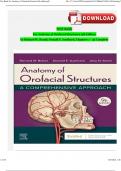TEST BANK
For Anatomy of Orofacial Structures 9th Edition
by Richard W. Brand; Donald E. Isselhard, Chapters 1 - 36 Complete
Test Bank for Anatomy of Oriented Structure 8th edition.pdf file:///C:/Users/HP/Downloads/Test%20Bank%20for%20Anatomy%2...
1 of 68 7/20/2024, 1:46 AM Chapter 01: Oral Cavity
Brand/Isselhard:AnatomyofOrofacialStructures,9thEdition
MULTIPLE CHOICE
1. A diastema is a space between two teeth in the same arch. When this occurs between the
maxillary central incisors, it is often the result of a pronounced labial frenum.
a. Both statements are true.
b. The first statement is true; the second statement is false.
c. The first statement is false; the second statement is true.
d. Both statements are false.
ANSWER: A
A space, or lack of contact area, between any two teeth in the same arch is called a diastema. When a
diastema occurs between the maxillary central incisors, it is often the result of a pronounced labial
frenum extending to the crest of the alveolar ridge and possibly over the ridge. This band of firm
connective tissue causes the erupting incisors to be pushed aside resulting in a diastema, or space.
Correction of a diastema usually involves surgical removal, or cutting, of the frenal tissue between
teeth.
REF: p. 3
OBJ: To describe the boundaries and sub-boundaries of the oral cavity and the structures in each area
NAT: CDA: GC I.A.6. Identify basic oral anatomy and physiology, including but not limited to: oralcavity.
TOP: BLOOM: Remembering
2. Torus palatinus is seen on the
a. soft palate
b. hard palate
c. alveolar ridge
d. oral pharynx
ANSWER: B
Torus palatinus is excess bone growth and occurs in the midline of the hard palate. It maygrow to
varying sizes and is generally only a problem when the construction of a maxillary denture is
necessary. In health, such bony protuberances, or excess bone growths, do not occur on the soft
palate, alveolar ridge, or oral pharynx.Test Bank for Anatomy of Oriented Structure 8th edition.pdf file:///C:/Users/HP/Downloads/Test%20Bank%20for%20Anatomy%2...
2 of 68 7/20/2024, 1:46 AM REF: p. 5
OBJ: To define the terms vestibule, oral cavity proper, mucobuccal fold, frenum, alveolar mucosa, gingiva,
exostoses, torus palatinus, and torus mandibularis
NAT: CDA: GC I.A.2. Identify basic oral anatomy and physiology, including but not limited to: bones.
TOP: BLOOM: Remembering
3. Contraction of which muscle raises the tongue upward?
a. Mylohyoid
b. Palatopharyngeal
c. Palatoglossal
d. Levator glossal
ANSWER: ATest Bank for Anatomy of Oriented Structure 8th edition.pdf file:///C:/Users/HP/Downloads/Test%20Bank%20for%20Anatomy%2...
3 of 68 7/20/2024, 1:46 AM Contraction of the mylohyoid muscle raises the tongue. The palatopharyngeal muscle and the
palatoglossal muscle form the posterolateral borders of the oral cavity. There is not a muscle by the
name of levator glossal.
REF: p. 7
OBJ: To define the landmarks in the floor of the mouth and the hard and soft palate and the structures that
form them
NAT: CDA: GC I.A.4. Identify basic oral anatomy and physiology, including but not limited to:
muscles. TOP: BLOOM: Remembering
4. The oral vestibule is partially bordered by the lips and cheeks. The oral cavity proper extends
posteriorly to the soft palate.
a. Both statements are true.
b. The first statement is true; the second statement is false.
c. The first statement is false; the second statement is true.
d. Both statements are false.
ANSWER: B
The oral vestibule is the space or potential space that exists between the lips or cheeks and teeth. In
an edentulous person, the vestibule would extend between the lips or cheeks and the alveolar
ridges. The oral cavity proper is surrounded by teeth or alveolar ridges and extends all the way back
to the palatine tonsils. This includes the region from the floor of the mouth upward to the hard
and soft palates.
REF: p. 2
OBJ: To describe the boundaries and sub-boundaries of the oral cavity and the structures in each area
NAT:CDA:GCI.A.6.IdentifNybasRUicoISralNaGnatoBmy.CandMphysiology,includingbutnotlimitedto:oralcavity. TOP:
BLOOM: Remembering
5. Each of the following is true of the uvula EXCEPT one. Which one is the EXCEPTION?
a. It is located at the most posterior portion of the hard palate.
b. It is located at the midline.
c. It is a downwardly projecting muscle.
d. It is necessary for swallowing.Test Bank for Anatomy of Oriented Structure 8th edition.pdf file:///C:/Users/HP/Downloads/Test%20Bank%20for%20Anatomy%2...
4 of 68 7/20/2024, 1:46 AM




